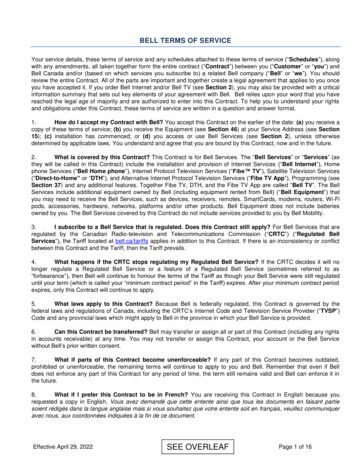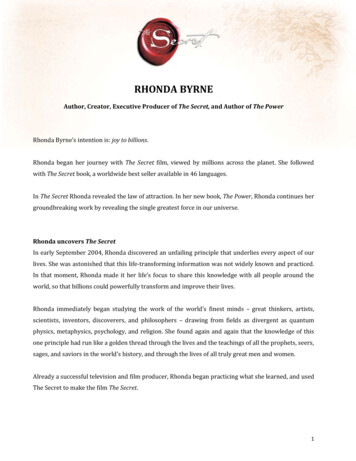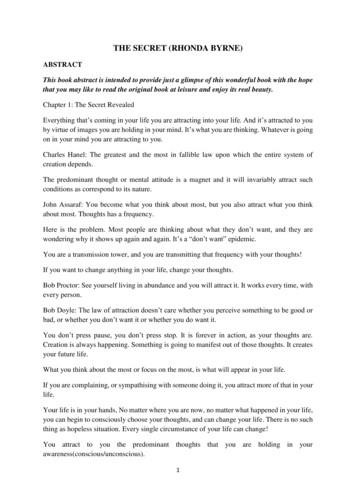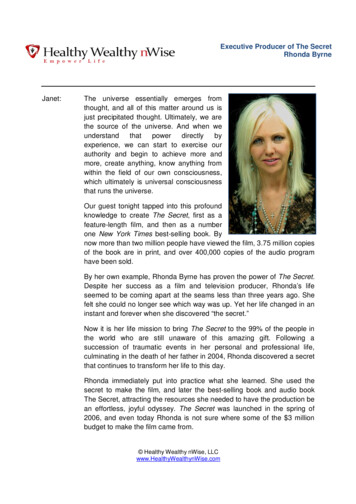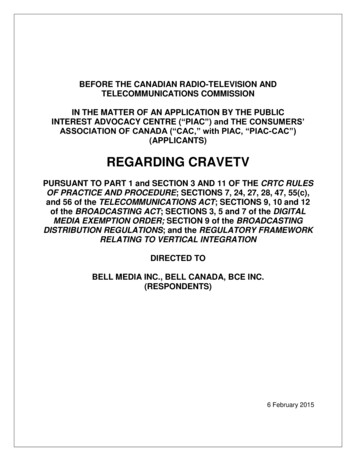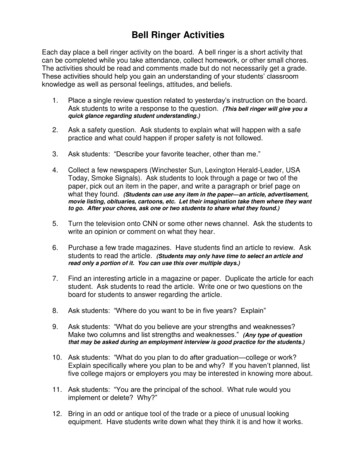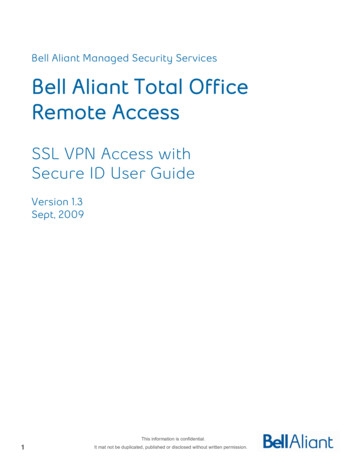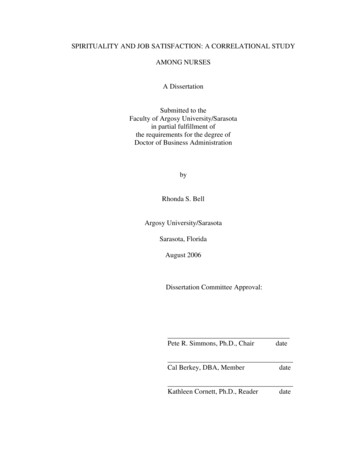
Transcription
SPIRITUALITY AND JOB SATISFACTION: A CORRELATIONAL STUDYAMONG NURSESA DissertationSubmitted to theFaculty of Argosy University/Sarasotain partial fulfillment ofthe requirements for the degree ofDoctor of Business AdministrationbyRhonda S. BellArgosy University/SarasotaSarasota, FloridaAugust 2006Dissertation Committee Approval:Pete R. Simmons, Ph.D., ChairdateCal Berkey, DBA, MemberdateKathleen Cornett, Ph.D., Readerdate
SPIRITUALITY AND JOB SATISFACTION: A CORRELATIONAL STUDYAMONG NURSESA DissertationPresented to theFaculty of Argosy University/SarasotaIn Partial Fulfillment ofThe Requirements for the Degree ofDoctor of Business AdministrationbyRhonda S. BellAugust 2006ii
Abstract of Dissertation Presented to theGraduate School of Argosy University/Sarasotain Partial Fulfillment of the Requirements for theDegree of Doctor of Business AdministrationSPIRITUALITY AND JOB SATISFACTION: A CORRELATIONAL STUDYAMONG NURSESbyRhonda S. Bell2006Chairperson:Member:Reader:Dr. Pete SimmonsDr. Cal BerkeyDr. Kathleen CornettDepartment:College of Business and Information TechnologyThe purpose of this study was to examine the relationship between spiritualityand job satisfaction among registered nurses and licensed practical nurses.Demographic characteristics such as age, educational levels, area of clinical practiceand tenure were also examined as relates to spirituality and job satisfaction levels.The study was conducted based on work (Ashmos & Duchon, 2002; Denton &Mitroff, 1999a) suggesting a direct relationship between meaningful work andspirituality and job satisfaction. Moreover, additional studies (Furino & Reineck,2005; Tuttas, 2002) suggested that nurses feel more satisfied with the intrinsic factorsof nursing when they feel that they are making a difference in the lives of others.A convenience sample of approximately 500 nurses in a hospital setting incentral Arkansas was originally surveyed for the study. The participants voluntarilyiii
completed the questionnaires either in a conference room adjacent to the dining roomof the hospital or at their work areas. A total of 259 responded to the request;however, only 240 completed surveys were used yielding a response rate of 49.5%.The three instruments used in this study were the Spirituality Assessment Scale (SAS)(Howden, 1992), the Minnesota Satisfaction Questionnaire (MSQ), Short-form(Weiss, Dawis, England, & Lofquist, 1967), and a demographic questionnaire.Pearson correlation calculations, showed a moderate significant positivecorrelation (r .452) between spirituality and general job satisfaction and a highersignificant positive correlation (r .495) between spirituality and intrinsic jobsatisfaction. Likewise, a less significant positive correlation (r .302) was foundbetween spirituality and extrinsic job satisfaction. These findings suggest thatspirituality is intimately related to job satisfaction, and support the literature (Furino& Reineck, 2005; Tuttas, 2002); that nurses may be more satisfied with the intrinsicfactors of job satisfaction when they are more spiritually oriented.An analysis of variance was used to test for the differences in the level ofspirituality and job satisfaction as relates to the demographic variables: Age,educational background, clinical practice, and job tenure. No differences were notedon the spirituality or general job satisfaction levels as relates to any of thedemographic variables of this sample.An interesting observation here was that the sample was not particularly welleducated, they were also somewhat older than expected and they were lessexperienced than one would imagine. These trends are a confirmation of the staffingproblems in the nursing field. Additional research is needed to generalize the resultsiv
to other nurse populations. Research is also suggested regarding the relationshipbetween spirituality and job satisfaction among nurses and the impact of these factorson patient satisfaction. Finally, practical personnel suggestions are outlined forhospital administrators and nurses regarding spirituality and job satisfaction.v
Copyright 2006 Rhonda S. BellAll Rights Reservedvi
DEDICATIONThis dissertation is dedicated to my two sons, Timothy A. Bell and Samuel K.Bell. These guys were thirteen and nine when I started this journey. Now at seventeenand thirteen they are seeing this journey of my life almost complete. Words cannotexpress the love I have for these two young men who have encouraged me immenselyto focus and finish the task. The countless hours of “Mom” time that they havesacrificed will never be forgotten nor taken for granted. I could have never made thisjourney complete without their help with chores, supper, and the understanding thatendurance and perseverance will always be rewarded. To these two special sons, Iwill always be grateful.vii
ACKNOWLEDGEMENTSFirst, I would like to acknowledge Jehovah God, Jesus, and the Holy Spirit fortheir strength, guidance, direction, words, and unfailing love through this entireprocess. There are a number of other people who have given so much of themselvesto help me complete this journey. First, Dr. Pete Simmons, my dissertation chair, hasgiven professional guidance and expertise beyond the call of duty. His desire foracademic excellence has inspired me as a professor, and the outstanding mentoringhas been a blessing in my life. Dr. Simmons truly desires to see students succeed andcares for them holistically. Sincerest appreciation is also extended to Dr. Cal Berkeyand Dr. Kathleen Cornett, members of my dissertation committee, who have givenprofessional advice and guidance.To my parents, Ernest and Janice Umberger, Jr. who have cared for my sons,made trips to Florida, and encouraged and blessed me to finish this journey; I ameternally grateful for their love and support. My biggest fan and supporter, my twinsister, Robin Morris, I extend much gratefulness for her love, support, and caringnature that carried me through the calm and through the storm. Thanks to Denver andOlivia Morris, and Evan Umberger for their support for Aunt Rhonda. Also, manythanks are extended to the best big brother in the whole world, E. C. Umberger, III,and his wife, Jo, for their phone calls and words of encouragement and love. Many,many, many thanks are extended to Christian family and special friends who neverstopped praying, encouraging, and believing. Many thanks are extended to mywonderful colleagues in the College of Business at Harding University. And last butviii
not least, my deepest appreciation is extended to all the nurses and administrativestaff for their time and support that made this research possible.ix
TABLE OF CONTENTSAbstract . iiiCopyright Page. viDedication . viiAcknowledgements . viiiList of Tables . xivCHAPTER ONE: THE PROBLEM . 1Introduction . 1Problem Background . 2Literature Review. 5Research Hypotheses . 11Limitations/Delimitations . 13Definitions. 14Importance of the Study . 16CHAPTER TWO: LITERATURE REVIEW . 18The Historical Perspective of Spirituality in Healthcare . 18History of Nursing . 18Defining Spirituality . 20The Root of Spirituality in Healthcare . 25Holistic Approaches to Healthcare . 28Holistic Health Care. 28The Spiritual Dimension of Health and Healing. 30x
Nurses and Spiritual Care . 35Historical Perspective of Organizations and Spirituality . 40Leadership Styles and Spirituality . 44Cautions and Concerns of Spirituality in the Workplace. 49Job Satisfaction and Stress in Healthcare . 51Job Satisfaction and Nursing . 52Stress and Nursing . 57Conceptual Integration . 60CHAPTER THREE: METHODOLOGY . 64Research Design. 64Selection of the Study Participants . 65Instrumentation . 66Assumptions or Limitations . 70Procedures . 71Data Processing and Analysis . 72CHAPTER FOUR: FINDINGS . 79Introduction . 79Survey Sample and Response Rates . 80Descriptive Statistics and Frequency Distributions . 81Age of the Participants . 81Educational Level of Nurses . 83Area of Clinical Practice . 84Tenure . 85xi
Research Questions and Hypotheses . 86Research Questions and Hypotheses . 86Alternative Hypothesis One . 88Alternative Hypothesis Two . 90Supplemental Analysis – Extrinsic Job Satisfaction . 91Alternative Hypothesis Three . 93Alternative Hypothesis Four . 94Alternative Hypothesis Five . 95Alternative Hypothesis Six . 96Alternative Hypothesis Seven . 97Alternative Hypothesis Eight . 99Alternative Hypothesis Nine . 100Alternative Hypothesis Ten . 101Summary . 102CHAPTER FIVE . 105SUMMARY, CONCLUSIONS, AND RECOMMENDATIONS. 105Summary . 105Conclusions . 112Recommendations . 117References . 120Appendix A . 138Appendix B . 139Appendix C . 141xii
Appendix D . 143Appendix E . 147Appendix F. 148xiii
LIST OF TABLESTable #DescriptionPageTable 1Age of Nurse Participants82Table 2Education Level of the Nursing Population83Table 3Area of Clinical Practice84Table 4Tenure of Nurses85Table 5Correlations between Spirituality and General Job Satisfaction89Table 6Correlations between Spirituality and Intrinsic Job Satisfaction90Table 7Correlations between Spirituality and Extrinsic Job Satisfaction92Table 8ANOVA: Spirituality and Age93Table 9ANOVA: Spirituality and Education Level94Table 10ANOVA: Spirituality and Area of Clinical Practice95Table 11ANOVA: Spirituality and Tenure of Nurses96Table 12ANOVA: General Job Satisfaction and Age98Table 13ANOVA: General Job Satisfaction and Education Level99Table 14ANOVA: General Job Satisfaction and Area of Clinical Practice100Table 15ANOVA: General Job Satisfaction and Tenure of Nurses101Table 16Summary of Results109xiv
CHAPTER ONE: THE PROBLEMIntroductionThe work environment in nearly every industry continues to be faced withnumerous challenges that require constant change. Globalization, competition,technology, reengineering and downsizing are just a few factors that are creating amore complex work environment and ones requiring transformational changesinitiated by leadership (Kotter, 1996). The healthcare industry is no different andsometimes brings even more challenges for management. The special concerns ofhealth care, life and death, patient care, and a profitable bottom line, make thisenvironment a particularly unique one. Over the last fifteen plus years, employeesand management in these settings have been relying more on a new organizationalculture, one that includes issues of spirituality in the workplace (Grant, 2004; Grant,O’Neil, & Stephens, 2004; Guillaume & McMillan, 2002; Schuster, 1997). It isalmost as if this spirituality emphasis is fulfilling some unsettled needs for bothmanagement and employees. Spirituality may be more prevalent in the healthcareindustry because of the past and present emphasis on holistic medicine whichinvolves the physical, psychological, social, and spiritual dimensions of the patient(Nightingale, 1860; Burkhardt & Nagia-Jacobson, 1989). Spirituality in health caremay also be a function of the life and death nature of many of the care-decisions thatare made in these environments; many of which may leave the health careprofessional drained or depleted of emotional resources (Aiken, Clarke, SilberSloane, & Sochalski, 2002; Carson, 1989; Furino & Reineck, 2005).1
This increased interest in spirituality within organizations has inspired manyprofessional health care organizations to include this topic during their annual events.During the 2003 annual Congress of the American College of Healthcare Executivesfive percent of the seminars were dominated by the topic of spirituality within theworkplace, and additional seminars addressed the topics of corporate culture, patientand employee satisfaction, staff shortages, Magnet hospitals, change management,outsourcing, and information technology strategies (Bell, 2003). Clearly, due to workpressures or world-worries with 9/11 and/or the terrorist threats of today, spiritualityconcerns have risen in general (Blair, Kaldahl, Seo, & Torabi, 2004; Collins et al.,2001).Problem BackgroundThe term “spirituality” encompasses several definitions in the medical andbusiness literature. Similarities in the definitions of spirituality include meaning andpurpose in life, interconnectedness to a Higher Power, individuals, or community;transcendence, compassion, caring, and valuing mankind (Condemi, Ferguson,Milliman, & Trickett, 1999; Delbecq, 1999; Denton & Mitroff, 1999; Fairholm,1996). One of the earliest definitions suggests spirituality in the realm of religion withone’s sense of and dependence on a Beyond that influences inner and outerexperiences (Clark, 1958). Frankl (1959, 1969) suggests that the spiritualencompasses the mind and the spirit without the emphasis of religion. Additionalauthors and researchers (Ashmos & Duchon, 2000; Denton & Mitroff, 1999a; Rojas,2002) have given much attention in trying to identify and measure spirituality as itrelates to the workplace. Furthermore, the definitions of spirituality in healthcare2
seem to center on meaning and purpose and understanding the person as a wholeincluding the physical, psychological, social, and spiritual dimensions (Allen &Rowe, 2004; Burkhardt & Nagia-Jacobson, 1989; Chiu & Greasley, 2001;Nightingale, 1860).The following question may be asked: Why is there a need for spirituality?Organizational spirituality concerns have been studied by classic organizationaltheorists (Follet, 1918; Greenleaf, 1980; Maslow, 1998) and even present dayenthusiasts (Dehler & Welsh, 1994; Denton & Mitroff, 1999a; Condemi, Ferguson,Milliman, & Trickett, 1999; Giacalone & Jurkiewicz, 2003). According to theseauthors, organizational spirituality may even include job involvement, organizationalintegration, purposeful leadership, task significance, self actualization, and selfmanagement. Some management experts (Condemi, Ferguson, Millman, & Trickett,1999; Denton & Mitroff, 1999a; Dhiman, King, & Marques, 2005; Garcia-Zamor,2003; Quatro, 2002) suggest, even, that spirituality can have a considerable impact onprofitability, organizational performance, motivation, organizational transformation,and job satisfaction. The inclusion of spirituality at work seems to be prompted by theworker’s desire to find meaning and purpose in one’s life, including the enormouspart of ones life that is spent in the workplace (Biberman & Whitty, 1997;Cavanaugh, 1999; Denton & Mitroff, 1999b; Fairholm, 1996; Freshman, 1999; King& Nichol, 1999; Marcic, 2000).Not only are workers searching for meaning and purpose in their lives atwork, but they are often confronted with patients who are often relying on meaningand/or purpose issues in their lives to cope with their illnesses and/or diseases3
(Albaugh, 2003; Brown, 2000; Chiu, Gartland, & Greasley, 2001; Allen & Rowe,2004; Walton, 2002). Patients who endure the adversities during cardiac surgery,cancer treatments, psychological treatments, and other treatments for chronic diseasesalso seem to be relying on the meaning and purpose of life to cope with their illnesses(Albaugh, 2003; Brown, 2000; Chiu, Gartland, & Greasley, 2001; Allen & Rowe,2004; Walton, 2002).The roots of spirituality in health care can be traced back to the Greek godsand goddesses with their emphases on baths, fasting, medications, and prophecies tohelp with rejuvenation of the body and mind (Matthews, 1992). Florence Nightingale,a British leader in the nursing profession, even referred to her profession as a calling,believing that the body, mind, spirit, and environment were all factors that unified thewhole person (Nightingale, 1860). Studies examining the role of spirituality andillness or disease, (Albaugh, 2003; Allen & Rowe, 2004; Bashmore, Crater, Green, &Koenig; Ganstrom, 1985; Walton, 1997) spirituality and health, (Arreloa,& Goodloe,1992; Brown, 2000; Coyle, 2002; George, Koenig, & Titus, 2004;) and spiritual care(Chiu, Gartland, & Greasley, 2001; Davis, 2003; Felgen, 2004) all help provide abackdrop in understanding some of the purposes of spirituality for healthcareproviders and their patients.Clearly, healthcare work offers an environment that can be very rewarding;however, continued staff shortages (Coile, 2001; Donley, 2005), the demands toperform with fewer resources (Furino & Reineck, 2005), the struggle for a profitablebottom line (Hood, Smith, & Waldman, 2003), the error rate in medicine (Leape,1994), and the strong pressures for quality patient care (Coile, 2001) can lead to a4
work environment filled with many pressures and lots of dissatisfaction and stress(Donley, 2005). These issues have raised concerns for the health care provider(Aiken, Clarke, Sloane, Sochalski, & Silber, 2002; Erlen, 2004; Donley, 2005; Mee &Robinson, 2003). The emotional stresses placed upon nurses to render the highestquality of care during times of staff shortages and administrative demands could beleading to the burnout of many nurses. In addition, the population of nurses isdecreasing with fewer individuals entering the nursing profession and theapproaching retirement age of the baby boomers (Mee & Robinson, 2003). Thedemands of the health care environment may have resulted in Jackson (2004) andO’Connor’s (2002) call for nurses to find coping mechanisms to decrease the stressesof their work, and that they find meaning and purpose in their work. One has towonder, however, how nurses perceive their work settings, are they as dissatisfiedwith their work settings as reported and one has to wonder if spirituality practicesmight help nurses deal with these pressures. The present study will examine therelationship between spirituality and job satisfaction among registered nurses andlicensed practical nurses. The researcher hopes to gain an understanding of therelationship between the elements of spirituality (purpose and meaning in life,innerness or inner resources, unifying interconnectedness, and transcendence) and jobsatisfaction (general job satisfaction, intrinsic satisfaction, and extrinsic satisfaction)levels among nursing professionals.Literature ReviewThe literature relevant to this study examines the history of spirituality as itrelates to healthcare, including a brief history of nursing in general, spirituality and5
how it is defined and relates to health care organizations, the holistic approach tohealthcare and how it relates to spirituality, the practice of spirituality among nursesin general, the historical development of spirituality as relates to managementpractices in organizations, and the final part of the literature review will addresses thestress levels of nurses and how they relate to job satisfaction levels and spirituality asa coping mechanism.The development of rendering care began as early as the patriarchal age(1950-1150 B.C.) with the mention of a nurse accompanying Rebekah in Genesis 24:59(Genesis 24:59 New International Version). The development of healthcareprogresses with the Greek gods and goddesses and the practice of nursing andspirituality with baths, fasting, medications, and prophecies (Matthews, 1992). Thedevelopment of formal nursing care can be most likely traced to the British lady,Florence Nightingale (Barnum, 1996; Bullough & Bullough, 1964; Roberts, 1954).Early developments of nursing education consisted of one year of training and anexamination to evaluate nursing skills and competencies (Roberts, 1954). Spiritualitywas a component of nursing care during these times with the approach to healthencompassing the body, mind, and spirit.The definitions of spirituality in healthcare seem to center on meaning andpurpose, and understanding the person as a whole including the physical,psychological, social, and spiritual dimensions (Allen & Rowe, 2004; Burkhardt &Nagia-Jacobson, 1989; Chiu & Greasley, 2001; Nightingale, 1860). Research (Allen& Rowe, 2004; Deckro, Mandle, & Stuart, 1989; Nightingale, 1860; Walton, 1997)suggests that the benefits of spirituality as relates to health include health benefits in6
terms of prevention, improved health status, recovery from illness, or enabling peopleto cope with illness and/or adversity. There has been an increased use of spiritualityin the healing process among the older population with chronic diseases (George,Koenig, Titus, 2004).The Joint Commission of Accreditation of Healthcare Organizations (JCAHO)requires healthcare institutions to accommodate the right to pastoral and otherspiritual services if requested (Joint Commission, 2005). Physicians and nurses have aresponsibility to perform a spiritual assessment to determine spiritual practices thatmay be important to the patient. Some research suggests that patients are not havingtheir spiritual or religious needs met during acute hospitalization (Burton, Fitchett,Sivian, 1997). Research indicates that nurses do believe spirituality could have aninfluence and a positive outcome on the patients’ health or meaning of their illness(Grant, 2004). This could mean that organizations need to consider a more holisticapproach to healthcare.A holistic approach to healthcare was evident very early with FlorenceNightingale’s (1860) philosophy of healing encompassing the connectedness of thebody, mind, and spirit of the person. More recent literature (Anderson, Coulon,Krause, & Mok, 1996; Burkhardt, 1989; Richardson, 1994) supports the approach tohealthcare as caring for the whole person, including the spiritual realm. The morerecent practice of complementary and alternative medicine (CAM) has boosted thepractice of holistic medicine (Esienberbg, 1998; Richardson, 2004).Nurses continue to integrate spiritual care to gain a more holistic approach tohealthcare (Albaugh, 2003; Brown, 2000; Chiu, Gartland, & Greasley, 2001; Walton,7
2002). Spiritual care from a nurse can be as simple as a gentle touch, openness tolisten, and the willingness to enter into a trusting relationship with the patient(Nussbaum, 2003). A spiritual assessment can help identify the spiritual needs of apatient, thus giving the nurse direction to rendering spiritual care to the patient(Tanyi, 2002). Prayer, a form of complimentary and alternative medicine and spiritualcare, has been studied in cardiac patients (Abbott, Kennedy, & Rosenberg, 2002; Ai,Bolling, Peterson, & Koenig, 2002; Bryant, Desai, & Ng, 2002) with results beingreduced adverse outcomes and lower complication rates. The role of spirituality is notonly unique to healthcare organizations, but organizations across other industrieshave been taking notice and considering the role of the spirituality in organizations(Ashmos & Duchon, 2000; Denton & Mitroff, 1999b).The increased awareness and concern for spirituality could be contributed toincreased downsizing and layoffs, corporate greed in the 1980s and 1990s, the agingof the baby boomers, the influx of women in the workplace, and most recently thethreats of terrorism (Ashmos & Duchon, 2000; Blair, Kaldahl, Seo, & Torabi, 2004Dehler & Welsch, 1994; Dhiman, King, & Marques, 2005). Literature supports theidea that employee’s are searching to find meaning and purpose in their work and intheir life (Biberman & Whitty, 1997; Denton & Mitroff, 1999b; Curry, 2003).Organizational spirituality has been defined with themes of empowerment and jobinvolvement (Condemi, Ferguson, Milliman, & Trickett, 1999; Giacalone &Jurkiewicz, 2003). Research suggests that organizational spirituality may; even havean impact on organizational performance (Condemi, et. al., 1999; Quatro, 2002).8
Although a 1999 Gallup poll showed seventy-eight percent of Americans feela need to experience spiritual growth, organizations will have to proceed with cautionas they consider spirituality in their organizations. Religious discrimination andlitigation expenses are present in today’s workplace (Huang & Kleiner, 2001).Government and regulatory organizations (i.e. Joint Commission of HealthcareOrganizations) have taken measures to protect and accommodate religious belief andpractices in the workplace and in healthcare (Huang & Kleiner, 2001; JointCommission, 2005). Regulations
Faculty of Argosy University/Sarasota . in partial fulfillment of . the requirements for the degree of . Doctor of Business Administration . by . Rhonda S. Bell . . made trips to Florida, and encouraged and blessed me to finish this journey; I am eternally grateful for their love and support. My biggest fan and supporter, my twin
